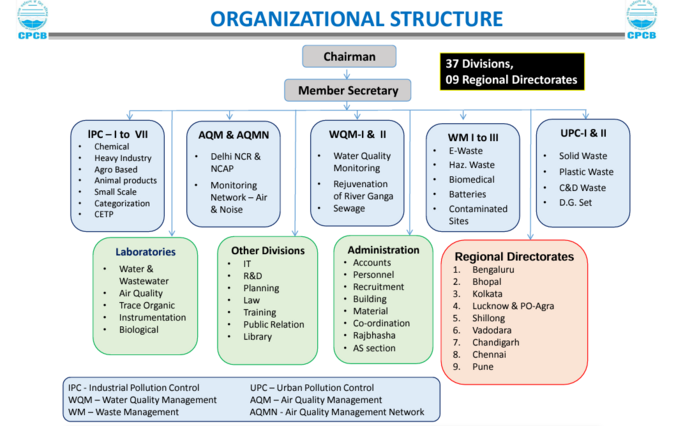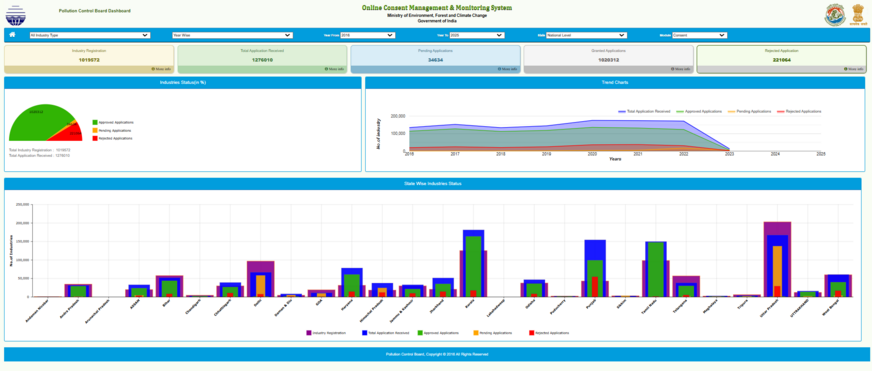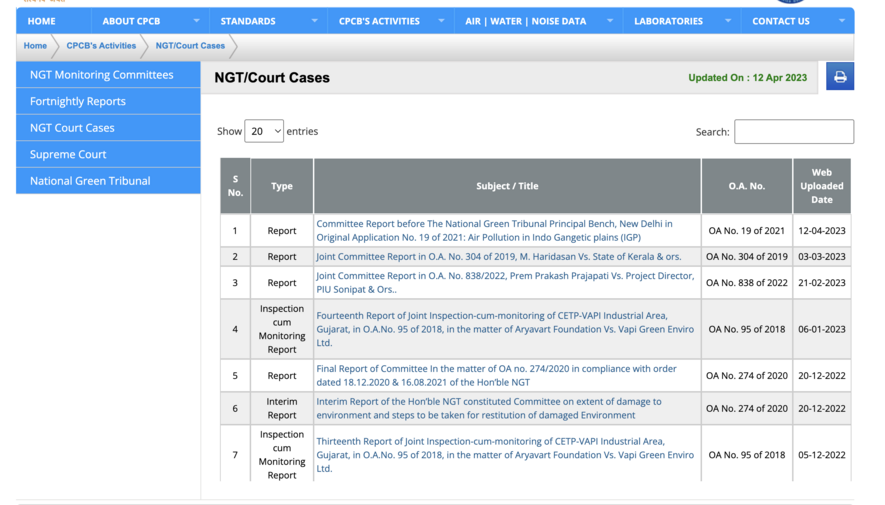Pollution Control Board
This page is now open for community updates
What is Pollution Control Board?
The Pollution Control Board in India refers to the government body responsible for regulating and monitoring environmental pollution to ensure a clean and healthy environment. At the national level, Central Pollution Control Board (CPCB) is a statutory body under the Ministry of Environment, Forest, and Climate Change that formulates policies, provides technical guidance, and oversees pollution control measures across India. State Pollution Control Boards (SPCBs) operates at the state level to implement the guidelines and policies set by the CPCB and enforce environmental laws. The Central Pollution Control Board (CPCB) also perform the functions of the State Pollution Control Board for all Union Territories through Pollution Control Committees (PCCs).
These boards monitor air, water, and soil quality, taking action against industrial and other pollution sources. They enforce laws like the Air (Prevention and Control of Pollution) Act, 1981, and the Water (Prevention and Control of Pollution) Act, 1974. Pollution Control Boards act as watchdogs to safeguard the environment in India and promote public health.
Official Definition of Pollution Control Boards
Pollution Control Board as defined in Legislations
Central Board and State Board
The Pollution Control Boards (PCBs) are defined under Air (Prevention and Control of Pollution) Act, 1981, and the Water (Prevention and Control of Pollution) Act, 1974 and are referred to as Central Board and State Board as the case may be
Section 2(g) of Air (Prevention And Control Of Pollution) Act, 1981 defines “Central Board”
the [Central Pollution Control Board] constituted under section 3 of the Water (Prevention and Control of Pollution) Act, 1974 (6 of 1974);
Section 2(o) of Air (Prevention and Control of Pollution) Act, 1981, defines "State Board”
- in relation to a State in which the Water (Prevention and Control of Pollution) Act, 1974 (6 of 1974), is in force and the State Government has constituted for that State a 2[State Pollution Control Board] under section 4 of that Act, the said State Board; and
- in relation to any other State, the State Board for the Prevention and Control of Air Pollution constituted by the State Government under section 5 of this Act
Pollution Control Committees
Section 4(4) of the Water (Prevention and Control of Pollution) Act, 1974 and Section 6 of the Air (Prevention and Control of Pollution) Act, 1981 provides that CPCB may delegate all or any of its powers and functions of a State Board in a UT under the said Acts to such person or body of persons as the Central Government may specify. The Central Pollution Control Board (CPCB) is empowered to perform the functions of the State Pollution Control Board for all Union Territories through Pollution Control Committees
Central Pollution Control Board
Composition of Central Pollution Control Boards
As per Section 3 of The Water (Prevention & Control of Pollution) Act, 1974, the composition of the Central Board is as follows:
- Chairman: A full-time Chairman nominated by the Central Government, who has special knowledge or practical experience in matters related to environmental protection or possesses knowledge and experience in administering institutions dealing with such matters.
- Government Representatives: Up to five officials nominated by the Central Government to represent the government.
- State Board Representatives: Up to five persons nominated by the Central Government from among the members of State Boards, with a maximum of two from local authorities.
- Non-Official Members: Up to three non-officials nominated by the Central Government to represent the interests of sectors such as agriculture, fishery, industry, trade, or any other area deemed necessary by the Central Government.
- Corporation Representatives: Two persons nominated by the Central Government to represent companies or corporations owned, controlled, or managed by the Central Government.
- Member Secretary: A full-time Member Secretary appointed by the Central Government, possessing the required qualifications, knowledge, and experience in the scientific, engineering, or management aspects of pollution control.

Functions of Central Pollution Control Board
Subject to the provisions of Section 16 of The Water (Prevention And Control Of Pollution) Act, 1974 (the Air Act) and Section 16 of The Air (Prevention And Control of Pollution) Act, 1981 (Water Act) and without prejudice to its functions under either Act, the main functions of the Central Board shall be:
- Overall Mandate: To promote the cleanliness of streams and wells in different areas of the States (under the Water Act) and to improve the quality of air and to prevent, control or abate air pollution in the country (under the Air Act). This essentially means working towards a holistic improvement of environmental quality.
- Advisory Role: To advise the Central Government on any matter concerning the prevention, control, or abatement of water and air pollution and the improvement of the quality of water and air.
- National Programme Planning and Execution: To plan and cause to be executed a nation-wide program for the prevention, control, or abatement of water and air pollution.
- Coordination and Dispute Resolution: To co-ordinate the activities of the State Boards and resolve disputes among them.
- Technical Assistance and Research: To provide technical assistance and guidance to the State Boards, and to carry out and sponsor investigations and research relating to problems of water and air pollution and their prevention, control, or abatement.
- Performing State Board Functions (as specified): To perform such of the functions of any State Board as may be specified by an order made under the respective Acts (e.g., in Union Territories).
- Training and Capacity Building: To plan and organize the training of persons engaged or to be engaged in programs for the prevention, control, or abatement of water and air pollution, on such terms and conditions as the Central Board may specify.
- Public Awareness Campaigns: To organize through mass media a comprehensive program regarding the prevention, control, or abatement of water and air pollution.
- Data Collection, Compilation, and Dissemination: To collect, compile, and publish technical and statistical data relating to water and air pollution and the measures devised for their effective prevention, control, or abatement. This includes preparing manuals, codes, or guides relating to treatment and disposal of sewage and trade effluents, as well as stack gas cleaning devices, stacks, and ducts, and disseminating information connected therewith. This include executing a nation-wide programme of ambient air quality monitoring known as National Air Quality Monitoring Programme (NAMP) and Real Time Water Quality Monitoring Network across Ganga Basin.
- Standard Setting: To lay down, modify, or annul, in consultation with the concerned State Governments, the standards for a stream or well (under the Water Act) and to lay down standards for the quality of air (under the Air Act). Different standards may be laid down for the same stream or well or for different streams or wells, having regard to the quality of water, flow characteristics, etc. example - National Ambient Air Quality Standards
- Establishment of Laboratories: To establish or recognize a laboratory or laboratories to enable the Board to perform its functions efficiently, including the analysis of samples of water from any stream or well or of samples of any sewage or trade effluents, and samples of air or emissions.
- Delegation of Powers: To delegate any of its functions under the Acts generally or specially to any of the committees appointed by it.
- Ancillary Functions: To do such other things and perform such other acts as it may think necessary for the proper discharge of its functions and generally for the purpose of carrying into effect the purposes of the respective Acts. These include implementation of Graded Response Action Plan for Delhi & NCR notified by Ministry of Environment, Forests & Climate Change through Environment Pollution (Prevention & Control) Authority vide S.O. 118 (E) dated January 12, 2017.
State Pollution Control Board
Composition of State Pollution Control Boards
As per Section 4 of The Water (Prevention & Control of Pollution) Act, 1974, The State Pollution Control Board (SPCB) is constituted by the State Government as a body corporate with the following members:
- Chairman- Nominated by the State Government, the chairman should have special knowledge or practical experience in environmental protection. The chairman can be whole-time or part-time. The service conditions of the chairperson is regulated by State Pollution Control Board (Manner of Nomination and other Terms and Conditions of Service of Chairman) Rules, 2024
- Officials- The State Government nominates a number of officials to represent the government, not exceeding five in number.
- Local authorities- The State Government nominates a number of people from the local authorities, not exceeding five in number.
- Non-officials -The State Government nominates a number of non-officials, not exceeding three in number, to represent the interests of agriculture, fishery, industry, trade, or any other interest.
- State-owned companies- Two people to represent the companies or corporations owned, controlled, or managed by the State Government.
The SPCB's main source of income is consent fees. The income is used to pay for staff salaries, pensions, infrastructure development, and other administrative expenses.
Functions of the State Pollution Control Boards
A State Pollution Control Board (SPCB) is a statutory body responsible for activities such as planning, monitoring, research, education, and training to address pollution control. The functions, as specified in Section 17 of Water (Prevention and Control of Pollution) Act, 1974, are summarized as follows:
- Comprehensive Pollution Control Program: Plan and implement comprehensive programs for the prevention, control, or reduction of air and water pollution.
- Advisory Role: Advise the State Government on matters related to the prevention, control, or reduction of air and water pollution.
- Information Dissemination: Collect and distribute information related to air and water pollution.
- Training Programs: Collaborate with the Central Board to organize training for individuals involved in pollution control activities.
- Technical Assistance and Research: Provide technical assistance, guidance, and sponsor investigations and research on issues related to water and air pollution and their prevention or control.
- Setting Standards: Lay down, modify, or annul standards for streams or wells and air quality in consultation with the State Government.
- Industry Suitability Advisory: Advise the State Government on the location and suitability of premises for industries that may cause air or water pollution.
- Effluent and Emission Standards: Establish standards for sewage and trade effluent treatment and for exhaust and stack gas cleaning systems for industrial plants.
- Water Pollution Control Areas: Identify and recommend areas within the state as Water Pollution Prevention and Control Areas, which may be officially declared by the State Government.
- Air Pollution Control Areas: Identify and recommend areas within the state as Air Pollution Control Areas under the Air (Prevention and Control of Pollution) Act, 1981, which may be officially declared by the State Government.
Consent requirement
An entrepreneur running or establishing any industry or process, and discharging effluent/emitting pollutants into any water resources or on land/air and polluting thereby the environmental water/air is required to obtain consent, which needs to obtained in two phases;
- Consent to Establish: This consent is to be obtained prior to establishing any industry or process.
- Consent to Operate: Once the industry or process plant is established along the required pollution control systems, the entrepreneur is required to obtain consent to operate the unit. This consent is given for a particular period, which needs to be renewed regularly.
Consent means the sanction of the authority of the Board for the discharge of the effluent (sewage or trade effluent into a stream or well or sewer or on land ) or emission of air pollutant into the atmosphere. The consent issued by Board under section 25 and Section 26 of the Water (Prevention and Control of Pollution) Act 1974 is known as water consent and under section 21 of the Air (Prevention and Control of Pollution) Act, 1981 is known as air consent.
As per section 25 of the Water (Prevention and Control of Pollution) Act 1974, no person shall without the previous consent of the State Board, Establish or take any steps to establish any industry, operation or process, or any treatment and disposal system or any extension or addition thereto, which is likely to discharge sewage or trade effluent into a stream or well or sewer or on land; or Bring into use any new or altered outlets for the discharge of sewage; or Being to make any new discharge of sewage. And, as per section 21 of the Air (Prevention and Control of Pollution) Act, 1981, no person shall without previous consent of the State Board, establish or operate any industrial plant in an air pollution control area.
Appearance in Official Database
Consent management and monitoring system
The online consent management and monitoring system of Ministry of Environment, Forest and Climate Change tracks the status of consent requirement under the law.

Consent Management and Monitoring System Dashboard. Accessible at: https://ocmms.nic.in/OCMMS_NEW/deshboard.jsp
Reports in furtherance of orders by court or National Green Tribunal
The official website of CBCP provides a database of NGT and Court cases pertaining to the Pollution Control Board.

The official website of CBCP provides a database of NGT and Court cases pertaining to the Pollution Control Board.
The NGT (National Green Tribunal) has constituted three committees on River Pollution, Hazardous Waste Management, and Industrial Pollution under the purview of Central Pollution Control Board
Annual Reports
The Annual Reports by Central Pollution Control Board (CPCB), State Pollution Control Boards (SPCBs) of Andhra Pradesh, Arunachal Pradesh, Assam, Bihar, Chattisgarh, Goa, Haryana, Himachal Pradesh, Jammu & Kashmir, Jharkhand, Karnataka, Kerala, Madhya Pradesh, Maharashtra, Manipur, Meghalaya, Mizoram, Nagaland, Odisha, Punjab, Rajasthan, Sikkim, Tamil Nadu, Telangana, Tripura, Uttar Pradesh, Uttarakhand, West Bengal and Pollution Control Committees like Delhi Pollution Control Committee giving detailed accounts of its constitution, meetings conducted within the year, committees constituted, efficacy of the water, air and noise monitoring network, researches, training programs and awareness drives conducted in relation to the environment etc.
International Experience
While India has established a robust framework for pollution control through the Central Pollution Control Board and State Pollution Control Boards, other countries have also developed innovative approaches to address environmental pollution.
- Decentralized Approach: Unlike India's centralized approach, some countries like Germany have adopted a decentralized approach to pollution control, empowering local authorities to take charge of environmental regulation.
- Public Participation: Countries like the United States have emphasized public participation in environmental decision-making, providing opportunities for citizens to engage in pollution control efforts.[1]
- Capacity Building: Countries like Japan have invested heavily in capacity building and training programs for pollution control officials, ensuring effective implementation of environmental regulations.
- Technological Innovation: Countries like South Korea have leveraged technological innovation, such as advanced air quality monitoring systems, to enhance pollution control efforts.
References
- ↑ Chiara Armeni, Participation in Environmental Decision-making: Reflecting on Planning and Community Benefits for Major Wind Farms, Journal of Environmental Law, Volume 28, Issue 3, November 2016, Pages 415–441, https://doi.org/10.1093/jel/eqw021
